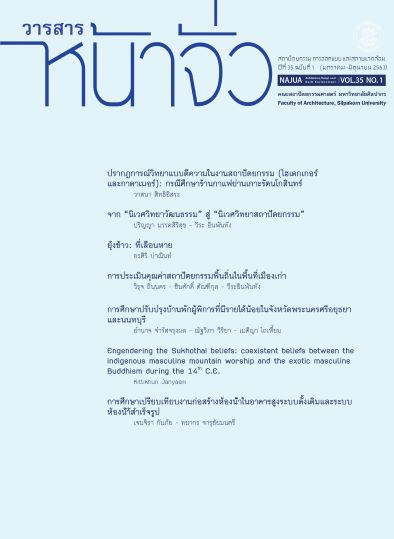The Vanishing Granaries
Keywords:
granaries, vanishing, ecology, peasants lifestyleAbstract
Tracing back around 20-30 years, from the contents of art exhibiting and book from Ornsiri Panin and Vira Inpuntung (2004), which had been studied the appearing of local wisdom in the Thai Granaries overall 4 regions. The contents of study stressed on the appearance, materials, structural systems, uses in combination with rites and rituals. Hence, both of them also raised the same questions about the vanishing of Thai granaries from the paddy fields. This article expects to give the clear answers of few question concerned. 1. The aspects in concerning the vanishing granaries. 2. Around the 4 regions, does the vanishing conditions are similar ?. 3. Without the scenery of houses and granaries, how should we recognized the Thai paddy fields life style”. For finding the real answers, other fields of study should be seriously concerned for conduction the reliable answers. Those are, the governmental economic and social policies on price production, village culture, agricultural systems in concerning with related data and result, the imagination of community food in concerning with site ecology, the relation of rice culture and fish culture. In finalized, the overall studies expressed that, the main aspect of the vanishing of Thai granaries are the governmental policies on rice production. The shifting system of keeping rice in local people granaries changed to leading all crops to the rice mill. The vanishing granaries clearly appeared on the Northern, Central and Southern Region which concerning with the offering of several crops cycles a year for expecting the large amount of rice production. But in the site with only one crop cycle a year with less rice production, which keep for their daily living only, the granaries are still alive. Especially in the Southern region, which the rice production depend on local ecology in combination with other agricultural production, the rice is only for daily living. Thus the Southern granary still remain. At present, when the granaries are fading away from Thai paddy scenery, the real peasants lifestyle should be appeared in combination with the whole natural and built environment and the condition of site ecology in addition with the chain of paddy living.
References
- Nartsupa, Chattip and Lerdvicha Pornpilai. (1994). Wattanatam Mooban Thai. (in Thai). [Thai Village Culture]. BKK: Sang Sun Press.
- Panin Ornsiri and Inpuntuang Vira. (2004). Yung Kao Yung Chang Hang Phoom Panya. (in Thai). [Granary of Knowledge]. BKK: Amarin Printing and Publishing.
- Panin Ornsiri. (2000). Panya Sangsan Nai Ruen Peun Tin Usakane. (in Thai). [Creativity in Southeast Asia Vernacular House]. BKK: J. Print
- Perez Rodrigo, D. and Other. (1989). Folk Architecture. Philippine: QCF Books.
- Sueklai, Sirodom. (2007). Satapattayakam Nai Wattanatam Kao Nai Loom Nam Yom Lae Loom Nam Chee Ton Lang. (in Thai). [Rice Culture Architecture on Southern Yom and Chee River Basin]. BKK: Silpakorn University.
- Yaimuang, Supa and Other. (2018). Chaona Kub Kwam Plenplang. (in Thai). [The Peasants and the Change]. BKK. Parppim Press.
- Yam Yeun, Kirengsak. (2012). Jintanakan Arharn Choom Chon. (in Thai). [The Imagination of Community Food]. Samutsakon: Pim Pa co.ltd.





